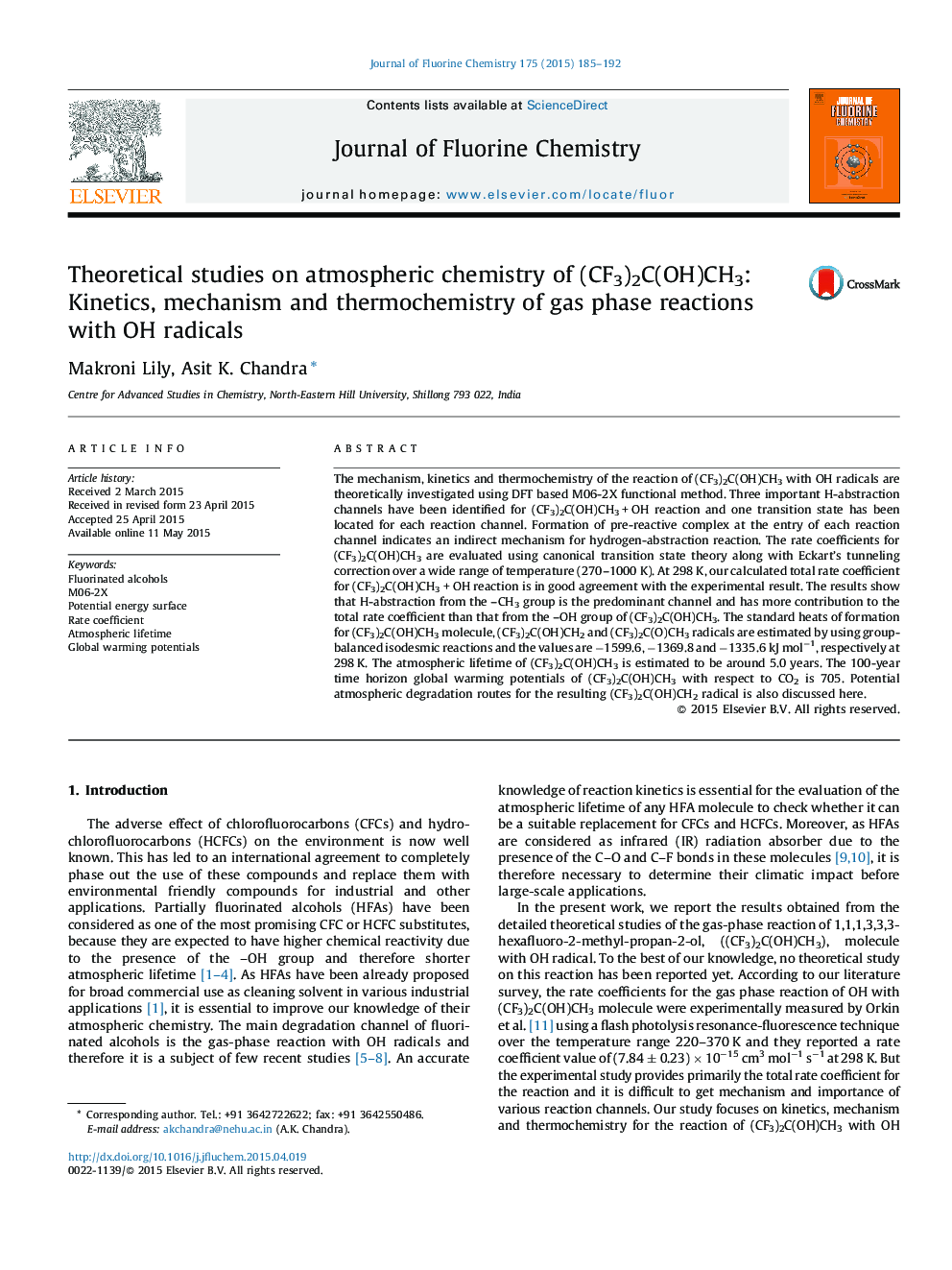| کد مقاله | کد نشریه | سال انتشار | مقاله انگلیسی | نسخه تمام متن |
|---|---|---|---|---|
| 1314027 | 1499325 | 2015 | 8 صفحه PDF | دانلود رایگان |

• (CF3)2C(OH)CH3 + OH reaction is investigated using DFT-based M06-2X method.
• Calculated rate constant values are in good agreement with the experimental results.
• Thermochemistry including BDE (D2980) and ΔfH2980 at 298 K are also reported.
• Atmospheric lifetime and GWP for (CF3)2C(OH)CH3 are estimated.
• Atmospheric degradation pathway is investigated.
The mechanism, kinetics and thermochemistry of the reaction of (CF3)2C(OH)CH3 with OH radicals are theoretically investigated using DFT based M06-2X functional method. Three important H-abstraction channels have been identified for (CF3)2C(OH)CH3 + OH reaction and one transition state has been located for each reaction channel. Formation of pre-reactive complex at the entry of each reaction channel indicates an indirect mechanism for hydrogen-abstraction reaction. The rate coefficients for (CF3)2C(OH)CH3 are evaluated using canonical transition state theory along with Eckart's tunneling correction over a wide range of temperature (270–1000 K). At 298 K, our calculated total rate coefficient for (CF3)2C(OH)CH3 + OH reaction is in good agreement with the experimental result. The results show that H-abstraction from the CH3 group is the predominant channel and has more contribution to the total rate coefficient than that from the OH group of (CF3)2C(OH)CH3. The standard heats of formation for (CF3)2C(OH)CH3 molecule, (CF3)2C(OH)CH2 and (CF3)2C(O)CH3 radicals are estimated by using group-balanced isodesmic reactions and the values are −1599.6, −1369.8 and −1335.6 kJ mol−1, respectively at 298 K. The atmospheric lifetime of (CF3)2C(OH)CH3 is estimated to be around 5.0 years. The 100-year time horizon global warming potentials of (CF3)2C(OH)CH3 with respect to CO2 is 705. Potential atmospheric degradation routes for the resulting (CF3)2C(OH)CH2 radical is also discussed here.
Atmospheric chemistry of (CF3)2C(OH)CH3 is theoretically investigated for the first time using DFT based M06-2X method. Three important H-abstraction channels have been identified for (CF3)2C(OH)CH3 + OH reaction and it has been found that the reaction proceeds through the formation of pre-reactive complex at the entry of each reaction channel. Our calculations suggest that the H-abstractions from the methyl group is thermodynamically and kinetically more favorable than that from the OH group of (CF3)2C(OH)CH3. However, contribution for H-abstraction from the OH cannot be neglected especially at lower temperature region. The thermal rate coefficient for the H-abstraction reaction of (CF3)2C(OH)CH3 with OH radicals is calculated to be 7.46 × 10−15 cm3 mol−1 s−1 at 298 K, which is in good agreement with the available experimental data. The atmospheric lifetime of (CF3)2C(OH)CH3 is estimated to be around 5.0 years and the 100-year time horizon global warming potential of (CF3)2C(OH)CH3 is calculated to be 705. Potential atmospheric degradation routes for the resulting (CF3)2C(OH)CH2 radical is also discussed in this work.Figure optionsDownload as PowerPoint slide
Journal: Journal of Fluorine Chemistry - Volume 175, July 2015, Pages 185–192